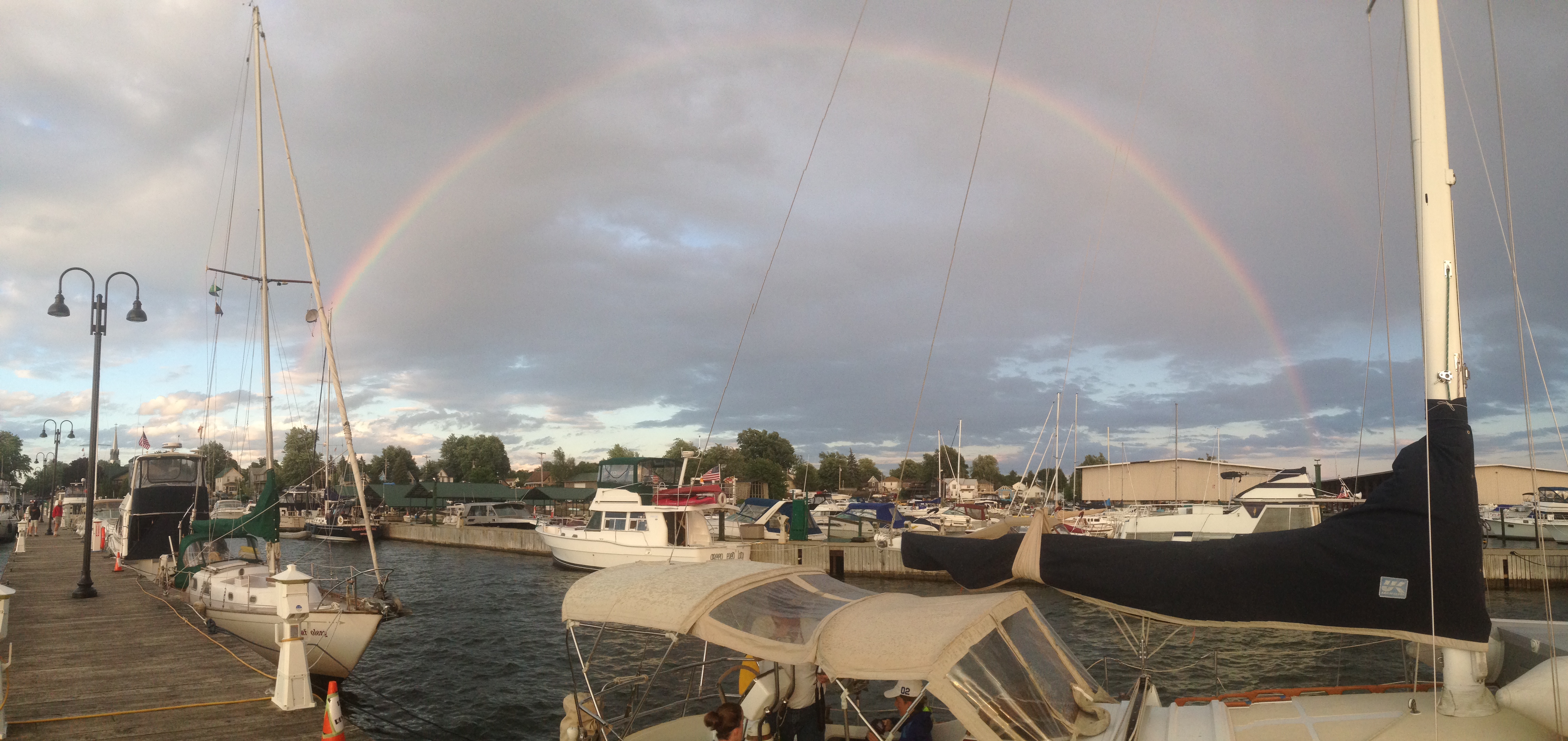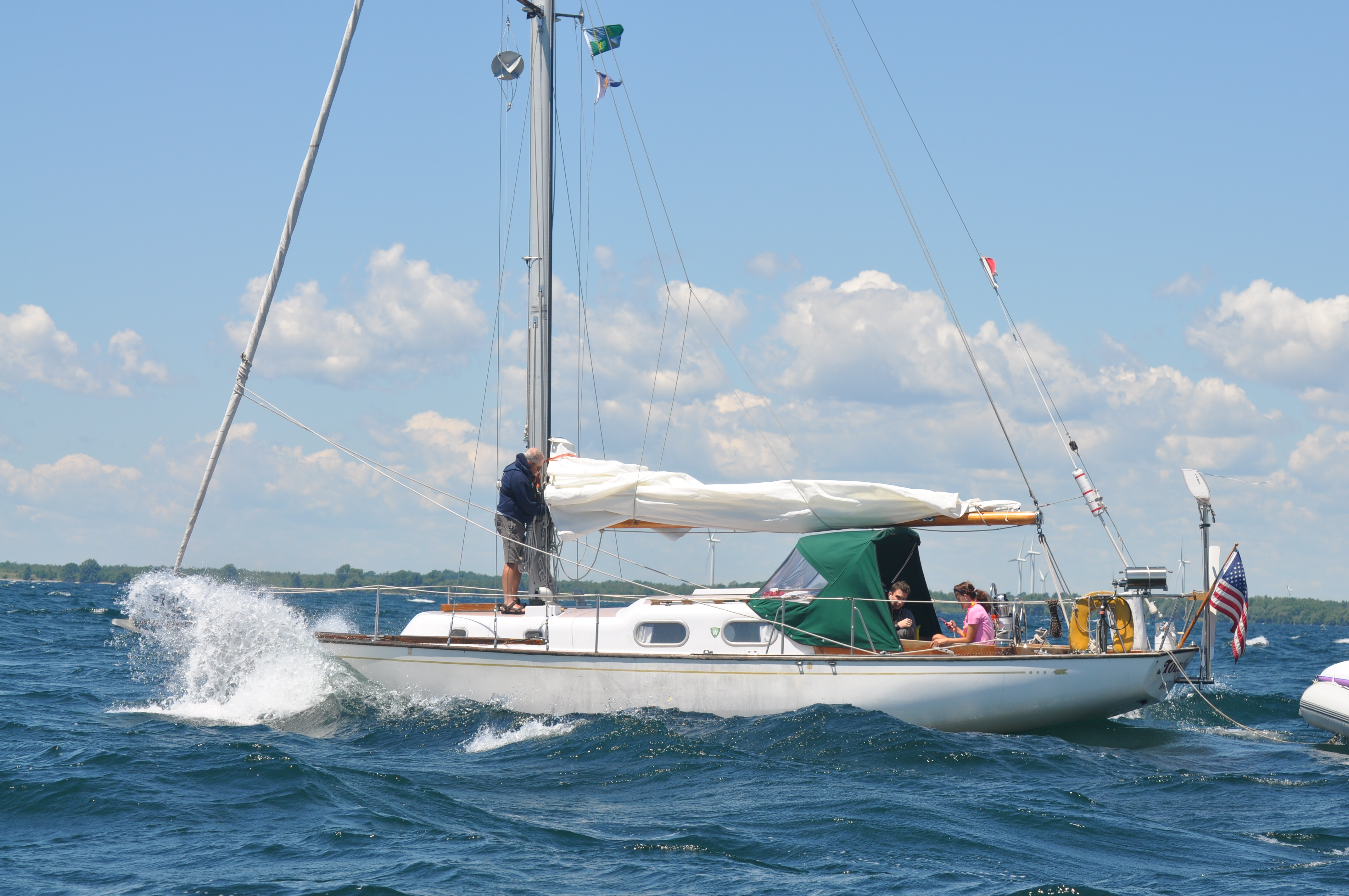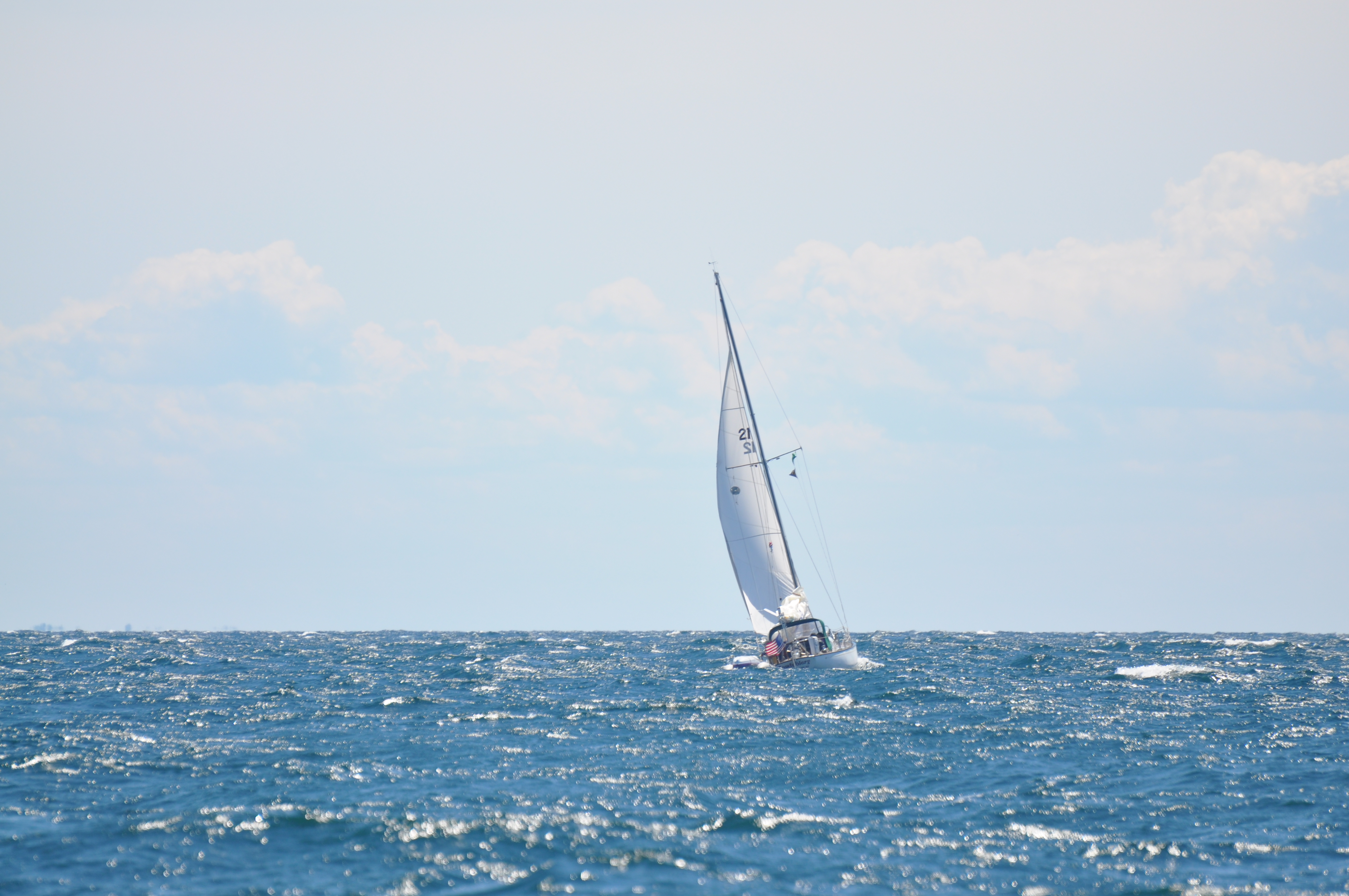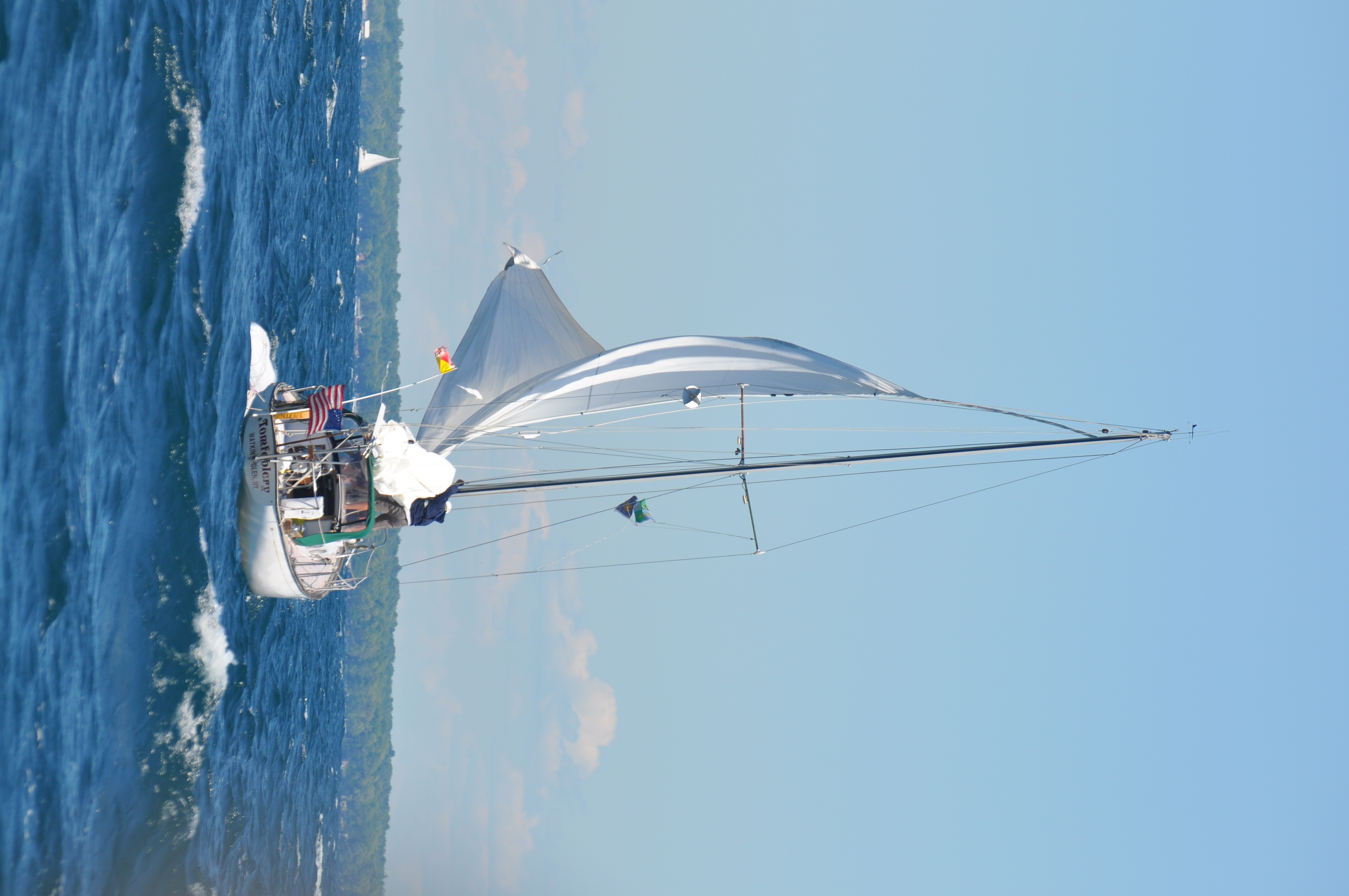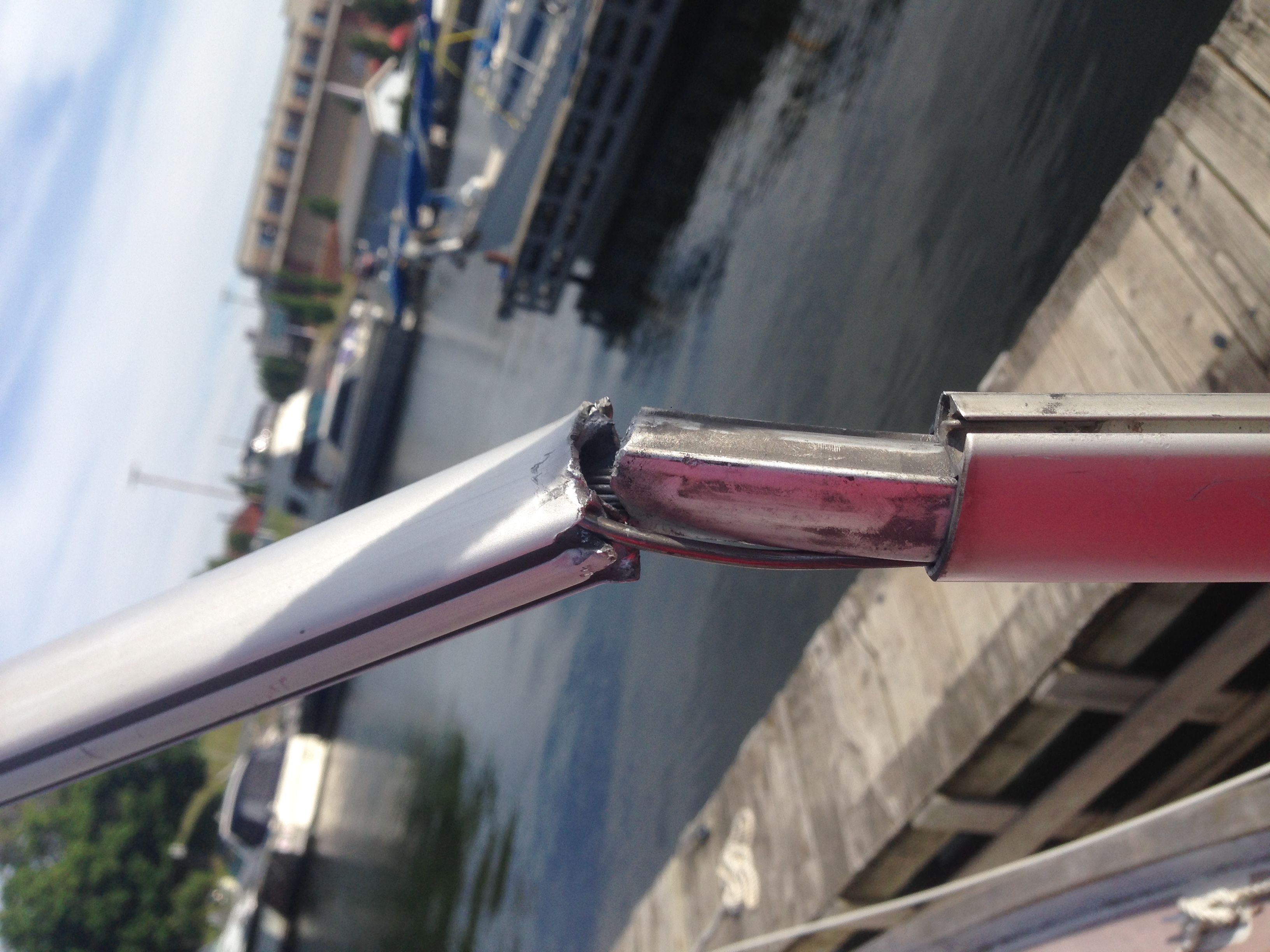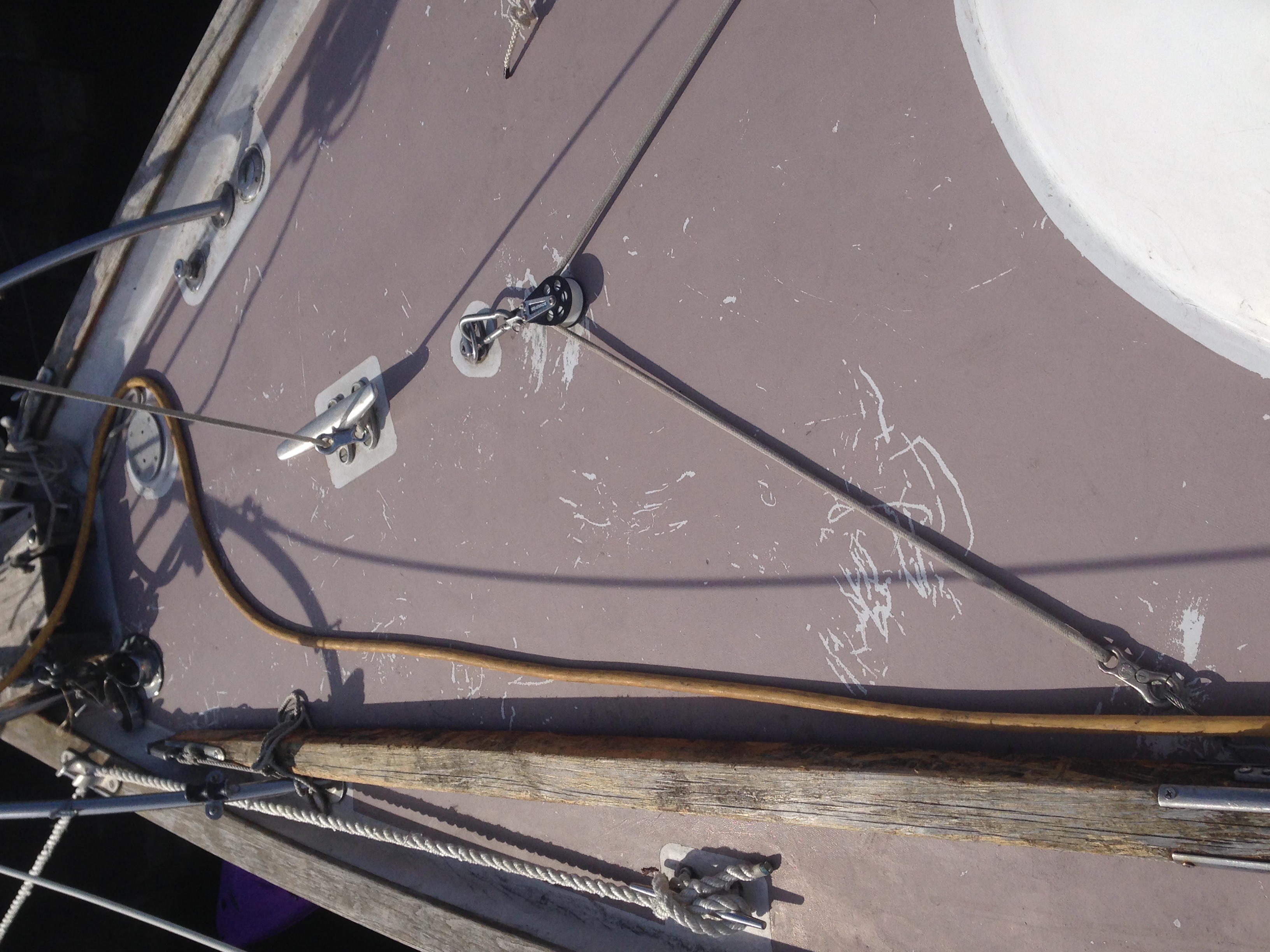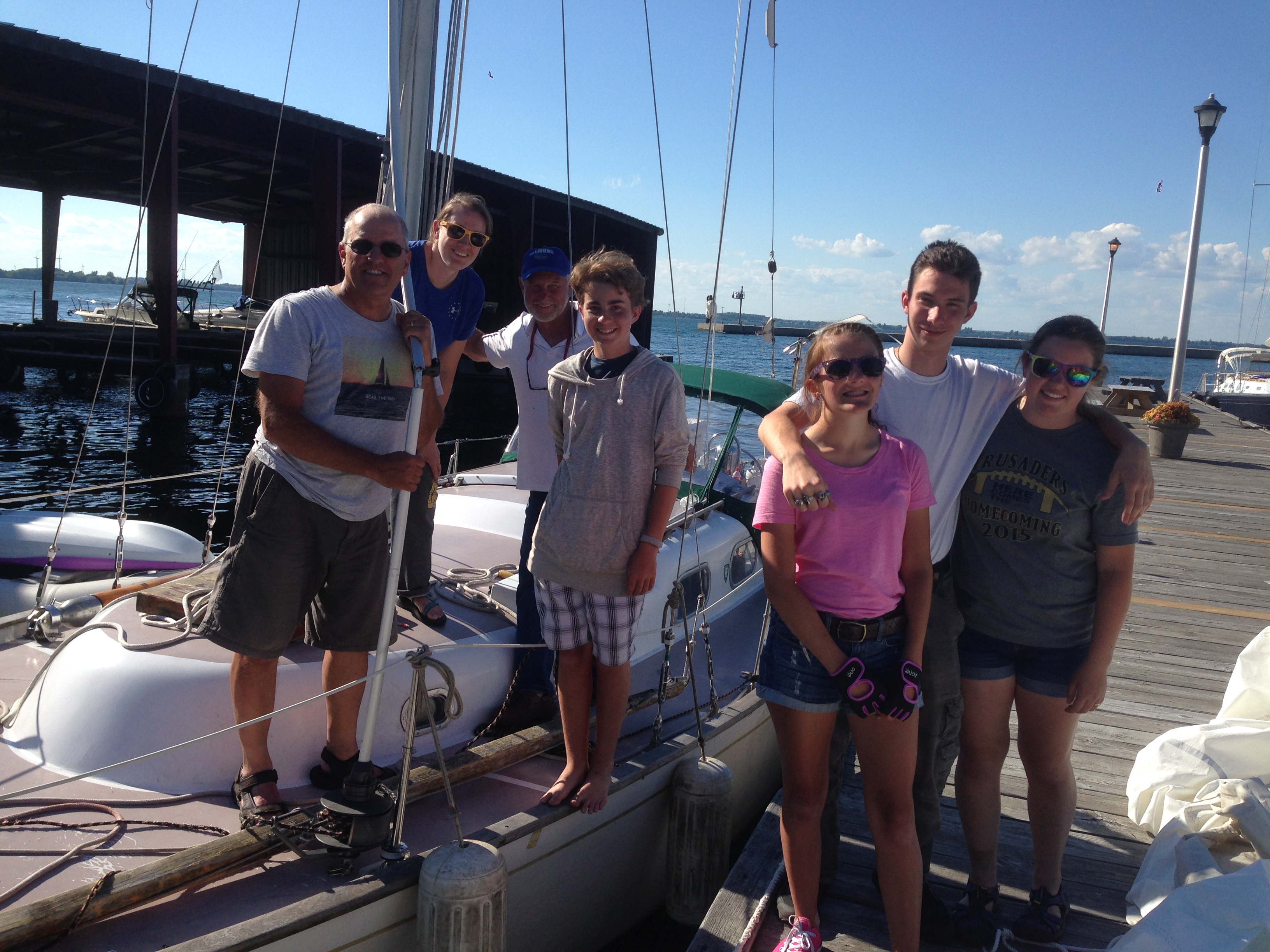Published in the Sep/Oct 2016 issue of Good Old Boat Magaine. Reprinted with permission.
by Thomas Alley, Hull #212
[To the tune of the Beverly Hillbillies Theme Song…]
Let me tell you a little story ‘bout an engineer named Tom.
Had a little boat that he sailed upon the pond.
Then one day he was going for a cruise,
And what happened next left a pretty nasty bruise!
Figuratively, that is.
Indelible. Unforgetable.
Well, Captain told the crew, “Kids, get away from there!”
The big, loud noise surely gave them all a scare!
And when the backstay started sagging toward the deck,
Captain then said, “Oh! What the heck??”
In sailing terms, that is.
With ‘sentence enhancers.’
Sunday Afternoon, July 3rd
It was just past two in the afternoon. The sun was shining brightly and the deep blue sky had just a few of those very picturesque, fluffy white clouds in it. The heat wave of the prior days had broken with the passage of a cold front the day before and the temperature and humidity had both dropped to comfortable levels. Winds were blowing from the west at about 15-18 knots and waves on Lake Ontario had slowly been building to 3-4 feet throughout the day. In other words, it was a near-perfect day for our Alberg 35.
We had just tacked onto starboard to clear the shoals on the southern end of Grenadier Island when there was a loud “bang”. The backstay went slack and nearly laid down in the cockpit. Our foresail, furler and forestay went off to leeward, still attached to the masthead, but not to anything else.
All I could think of at that moment was, “Oh, no! We’re going to lose the mast…”
One Week Earlier, Sunday Morning, June 26th
Anticipation was in the air. Our fleet of two vessels was ready to depart on a grand adventure from the sheltered waters of Seneca Lake and travel through the New York canals to Lake Ontario where our more experienced Junior Sailors would get a taste of voyaging on some bigger water. For Tomfoolery, a 1965 Alberg 35, it would be a homecoming of sorts as she had spent most of her 51 years sailing on Lake Ontario and among the Thousand Islands of the St. Lawrence River. Accompanying us was Seek Ye 1st, a 1973 Islander 36, also a veteran of those same waters.
With masts stepped and secured on our decks, and with both vessels laden with as many provisions as could be stored, we set off mid-morning. Two days later our small fleet reached the port of Oswego, NY. Weather had been good and the canal traffic was light. Our students got to experience canal travel, including a pair of tandem locks in Seneca Falls with a total drop of nearly 50 feet, and miles of motoring through the Montezuma swamp in central New York. The next day we stepped our masts, bent on the sails, and set out onto the “big lake” (to us) for a cruise to Sodus Bay and then later to the St. Lawrence river and the Thousand Islands.
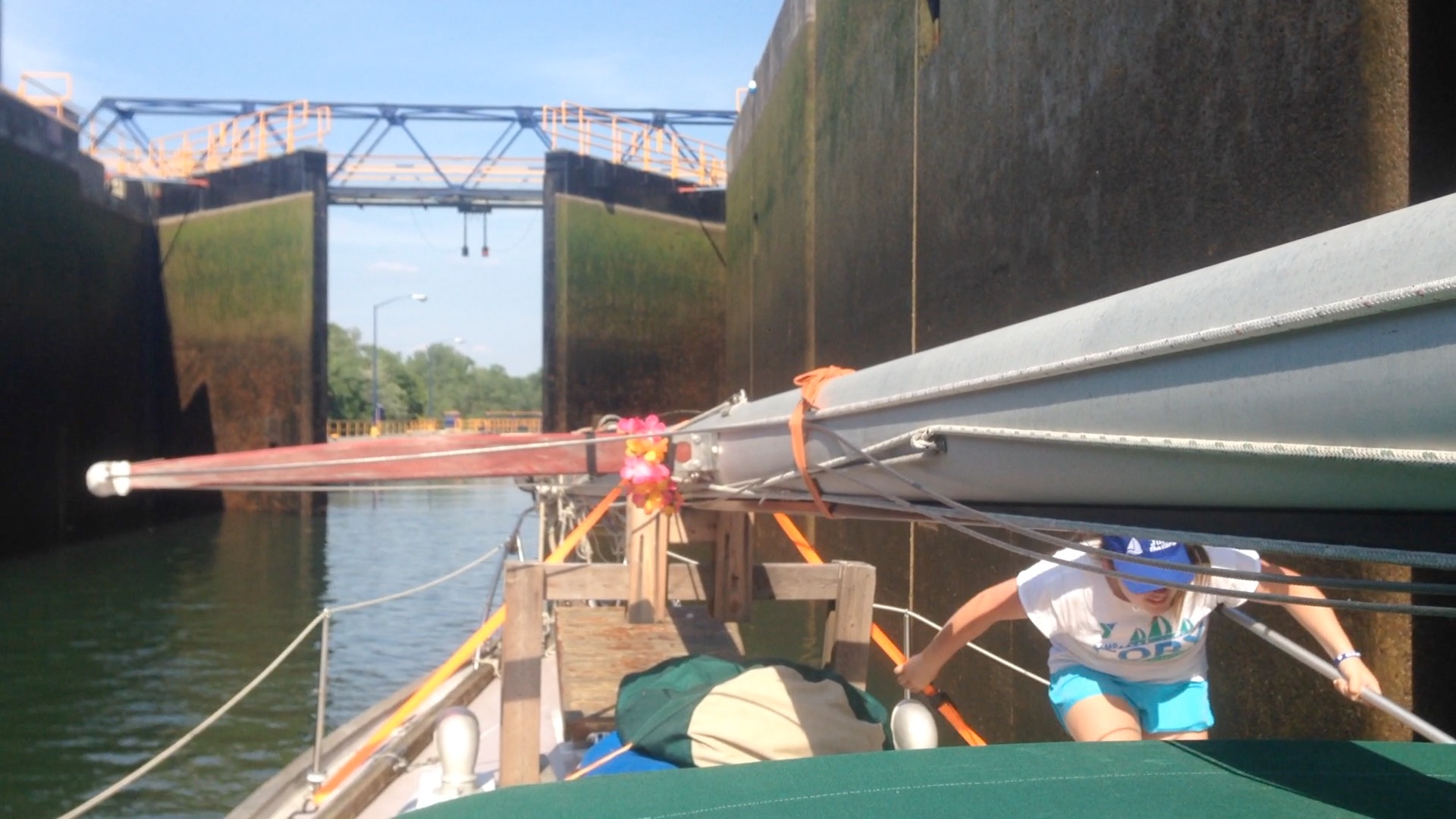
Photo 1- Tomfoolery leaves Lock CS-3 in Seneca Falls, NY.
Photo 2 - Seneca Junior Sailing students in front of the Boldt Castle Playhouse on Heart Island near Alexandria Bay, NY. (L-R) Henry, Katie, Maggie and Isaac.
Photo 3 - The Junior Sailing fleet in Clayton, NY under a full rainbow We were all hoping that it was a sign for a peaceful passage to Henderson Bay and Sackets Harbor the following day.
Sunday Morning, July 3rd
We left Clayton, NY shortly after 0900 in the morning and motored southwest on the St. Lawrence toward Lake Ontario, where we intended to sail south and stop for the night in Sackets Harbor then head home the following day via Oswego and the New York Canal System. Winds were right on our nose as we motored up the river toward the lake. As we got closer to the river mouth, waves began to increase, making for some dramatic photo opportunities.

Photo 4 & 5 - Seek Ye 1st plows through the waves funneling into the St. Lawrence River from Lake Ontario.
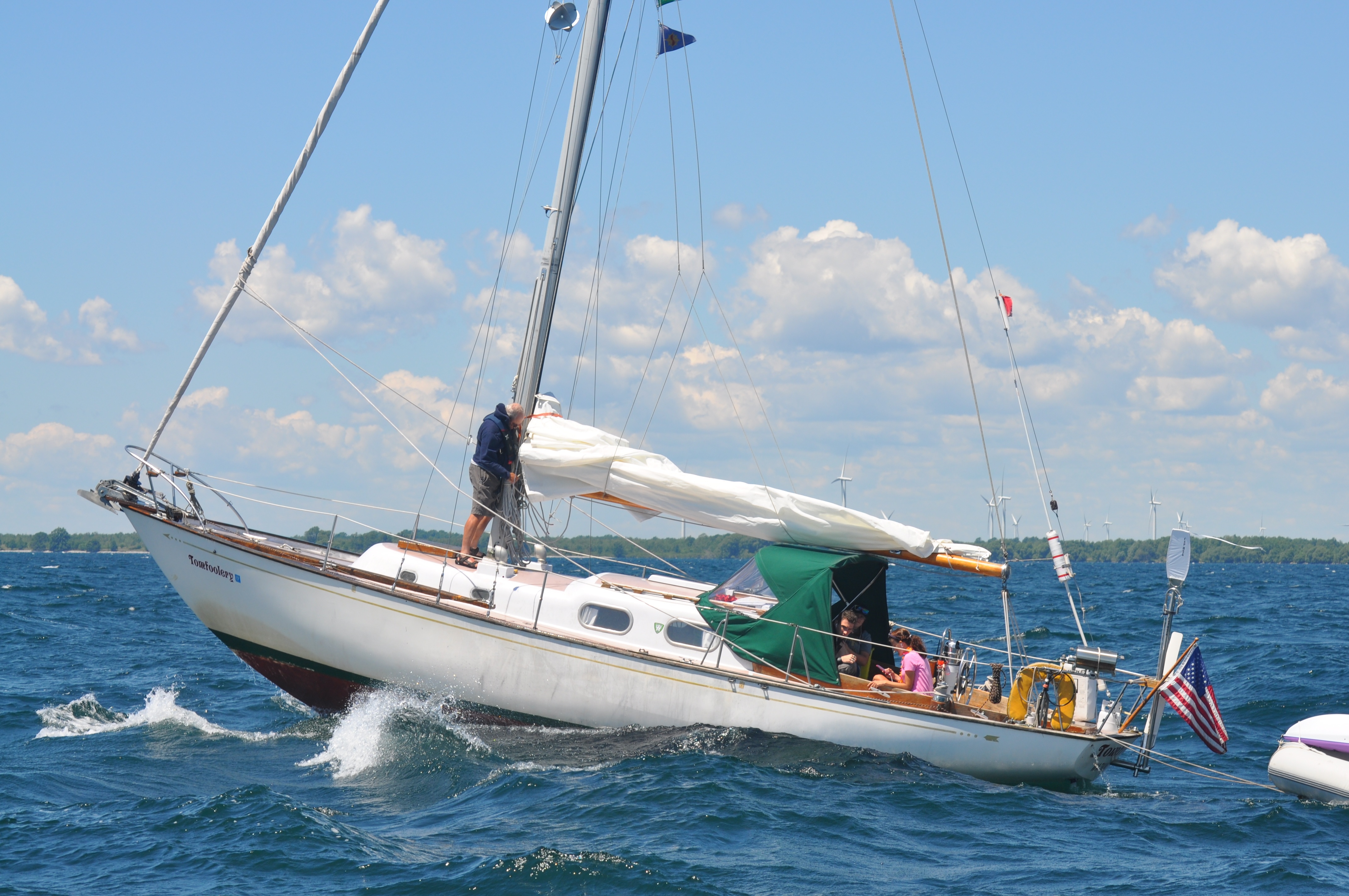
Photo 6 & 7 – Tomfoolery also splashes through the waves as she approaches Lake Ontario.
Upon leaving the river and entering the lake, we were able to bear off a bit to the south. Both Tomfoolery and Seek Ye 1st elected to fly under jib alone in order to reduce some of the pitching and rolling from the waves. The day held great promise, and in just a few hours we would clear the Grenadier Island shoal and be able to enjoy a nice reach into Henderson Bay. Or so we thought.
Sunday Afternoon, July 3rd
The loud bang that startled Tomfoolery’s crew also motivated them into action. The helm was immediately thrown over so as to point the boat downwind such that wave action would be reduced and any wind-induced stresses on the rigging would be directed forward. The jib sheets were slacked to further reduce stress on the mast. Crew were sent to the foredeck to perform damage-control and to secure the now flogging sail and the flailing furler and forestay. A radio call to Seek Ye 1st, sailing about a half mile from us, was made to inform them of our plight and to request they stand by to assist. Training kicked in and the Junior Sailor crew sprang into action without question or hesitation.
Photo 8 – Tomfoolery just prior to her forestay failure.
Photo 9 – Tomfoolery immediately after her forestay failure. Note the lee shore…
The first order of business was to secure the mast to prevent it from falling over. Halyards on the forward side of the mast proved useless because they had become fouled during the gyrations of the forestay and foresail, so the main halyard and its spare were run forward and used instead. These were tied to the anchor platform and then tensioned to minimize the mast “pumping” in the waves, which had now grown to about 4 or 5 feet. Work on the narrow foredeck was challenging, as the short period of the waves was causing us to bury the bow into every third one.
Once the mast was secured, the next order of business was to snuff the foresail. This proved to be extremely challenging as the furler had been seriously damaged and the sail, partially reefed at the time, had become so tangled that it could neither be furled, unfurled or lowered. Manually attempting to rotate the entire furler assembly also proved futile as the fouled jib halyard had effectively locked the top of the furler in place. In the end, we freed up the main halyard and led it forward. (After all, we weren’t going to be doing much sailing at this point.) Timing ourselves with the waves, the crew attempted to wrap the halyard around the still flogging sail in order to snuff it to the remains of the forestay and furler. This was marginally effective, but the pitching of the boat and the narrow foredeck made it impossible to get a good enough angle to snare all of the sail.
After nearly an hour of this, Tomfoolery’s exhausted crew radioed Seek Ye 1st to see if they could spare a crew member to provide some relief. They did so by coming alongside and, using their dinghy as a “floating bridge”, transferred Coach Andrea aboard. At this point, Tomfoolery had been drifting down onto a lee shore of Grenadier Island for over an hour, and the depth sounder was showing less than 40 feet. An attempt to motor to windward proved ineffective, plus the wave action placed unacceptable stresses on the jury rig holding up the mast, so the decision was made to retreat to the closest leeward harbor that could provide shelter: Cape Vincent.
Three hours later, both Tomfoolery and Seek Ye 1st arrived safely in Cape Vincent’s sheltered harbor. The crew (and captains) could breathe again!
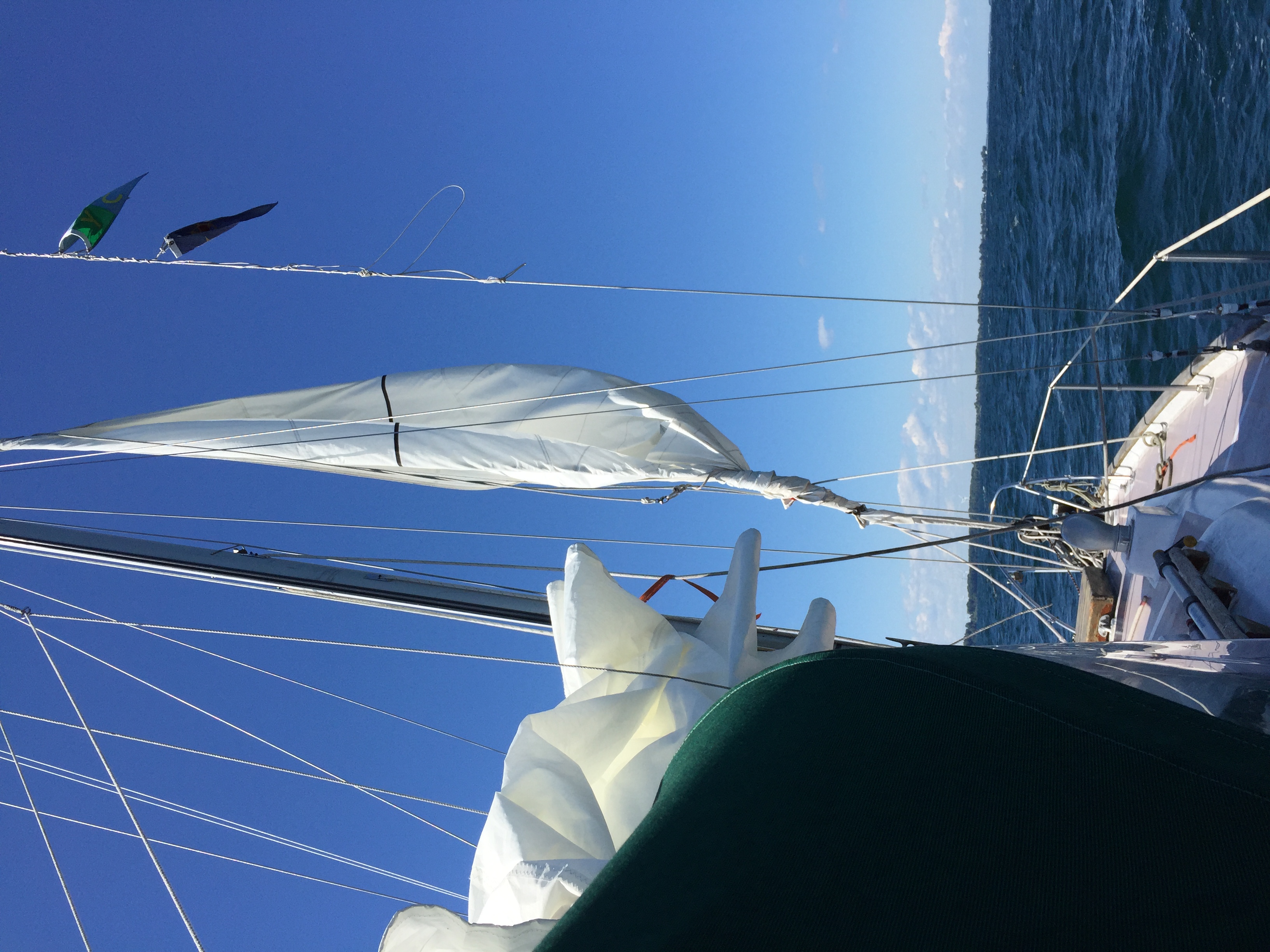
Photo 10 & 11 – Deck level view of the partially snuffed foresail and jury rig employed by Tomfoolery’s crew to get back to a safe harbor.
Sunday Evening, July 3rd
With a few hours of daylight left, both crews worked together to clean up the hastily made jury rigging aboard Tomfoolery and to see if she could be secured sufficiently for a trip back to her home port on her own keel. It was here that we discovered the extent of the damage sustained along with what we believe to be the root cause.
The first order of business was to get the sail down and reduce weight and windage aloft. It was a disheartening scene. It took almost an hour to unwrap the sail from the furler. Not one section of the furler foils had escaped damage. Each one had a twist, kink or bend in it. At least one joint had sheared resulting in the sail being wrapped not just in unequal amounts at different levels of the stay, but also in opposite directions. Needless to say, the sail was ripped in several places and seriously stretched out in others.
With the sail unwrapped, came the next question of how to get it down. The upper section of the foil had a sharp bend in it at the location of the upper swivel. It wasn’t going to move without a lot of persuasion, so that meant someone had to climb the mast to free the sail from its halyard. Given the condition of the mast and the risk involved, the captain could not order any crew aloft with a clear conscience, so he climbed into his harness.
With the foredeck partially cleared off the spinnaker halyard was freed and was used as a primary forestay for the mast. In addition, the main halyard was used as a secondary forestay and cinched tight. The boom was removed from the mast to further reduce any force that would tend to pull the mast aft. (Keep in mind that our boom is 15 feet long and made of solid spruce, weighing about 130 lbs.) This freed up the spare main halyard and the boom topping lift, which could be used as a safety line. At this point, the captain ascended the mast.
Once at the top, it did not take long to detach the foresail from the furler swivel and start helping it down the damaged furler foils. The jib halyard was also retrieved from the swivel and pulled back down to deck level where it could be used to help secure the mast. After the captain made it safely back to deck level, we got a better look at the damage to the forestay and furler.

Photo 12 – The damage to Tomfoolery’s forestay becomes apparent after the foresail was removed.
Photo 13 – Close up of Tomfoolery’s damaged furling unit showing the joint that sheared apart when the forestay failed.
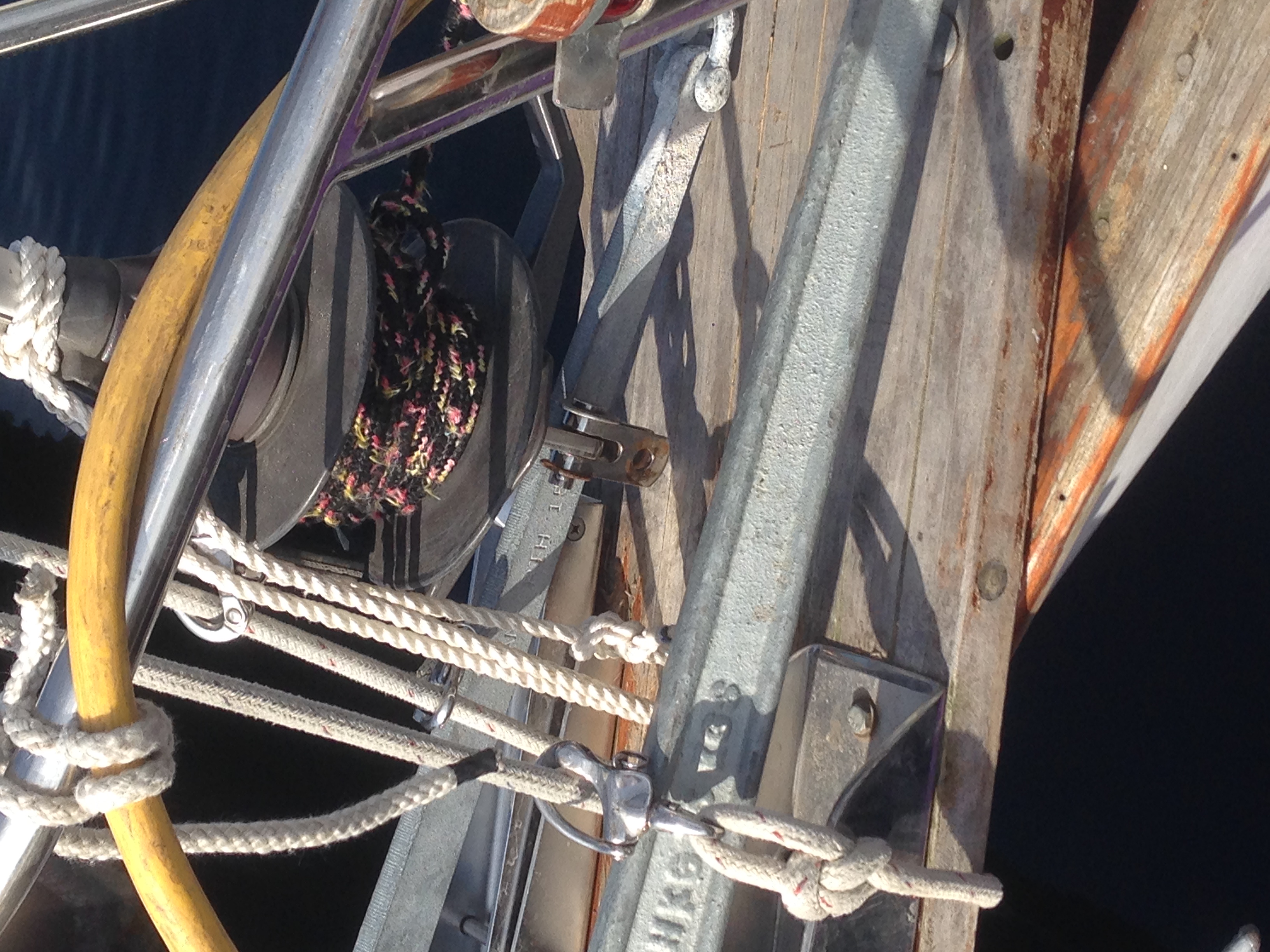
Photo 14 – Close up showing where Tomfoolery’s forestay came undone.
Photo 15 – Gouges on Tomfoolery’s foredeck from the flailing sail and furler.
With the foredeck cleared of debris, the crew used the jib and spinnaker halyards as temporary forestays, attaching them to the anchor platform which is solidly bolted to the hull and deck. The furler/forestay was then secured using a short line to the bow stem chainplate so that it would not flail around excessively during the remainder of the trip home.
The forecast for the next day was for light and variable winds and waves of less than two feet, which would make for a reasonably comfortable trip for our injured boat back to Oswego, where the mast was to be taken down anyway for our trip back to Watkins Glen through the New York canals.
Analysis
During the cleanup, a curious piece of debris was found on deck, which helped explain what had happened.
Photo 16 - What caused it all. A piece of the clevis pin that held the bottom of the forestay to the boat.
It was the end of the clevis pin used to hold the forestay to the bow stem chainplate. It appeared that the pin had fractured just behind the cotter pin a while back, probably due to fatigue. The stresses on the pin in wind and waves continued to work the pin and propagate the crack (note the different shades of darkening along the fracture surface) until it was sufficiently compromised to come completely apart that Sunday afternoon and allow the forestay to separate from the boat.
With the bottom of the forestay free, the sail then flew to leeward until it was held back by the furling line which was still attached to the boat. By this time the slack of the furling line was used up, the furler and sail had gained sufficient momentum to really jerk on the furling line. The sudden load on the furler is what presumably sheared the lower joint in the furler extrusion (photo in previous section). At this point, the lower part of the sail started to furl while the rest of the sail tried to unfurl, causing a number of stresses in both the furler and in the sail. The torsional loads on the extrusion, combined with the whipping action of the sail in the wind and the lack of support from a taut forestay is what likely caused the damage observed in the furler foil sections.
Retrospect and Conclusions
What is truly frightening about this incident is that the rigging was inspected the week prior when the mast was unstepped for the outbound trip in the canals. The shrouds were fine and all of the pins appeared to be in good condition. The photo of the shorn clevis pin, however, tells a different story. The pin had failed some time ago. Long enough for the defect to propagate and show signs of corrosion before it ultimately failed.
Ultimately, the problem was not the clevis pin, but complacency. Our brethren in salt water and in areas that have year-round boating seasons have learned hard lessons about corrosion and metal fatigue and are, as a result, rigorous in their vigilance to ensure the reliability of their rigging. Living further north, in fresh water and with low duty cycles on our boats, it’s very easy to become complacent with these inspections.
While I have made it a habit to drop the mast at least once every five years to inspect all of the rigging, and of doing opportunistic inspections whenever the mast was taken down for other reasons, it becomes easy to overlook details and to put off some things until “later”.
I’ve read numerous accounts of boat owners replacing their standing rigging every five to ten years to offset the effects of salt water and to prevent the incident we just experienced. It stands to reason that fresh water sailors should do the same, but perhaps on a more appropriate schedule, say 10-15 years?
Looking back, our family purchased Tomfoolery in 1996 – 20 years ago. (Where did the time go??!!) While we have replaced a few of the clevis pins (usually after the original was dropped overboard during some other type of maintenance), we’ve never deliberately retired any component of the standing rigging. This means everything is at least 20 years old. As a result of this incident, all of the clevis and cotter pins on Tomfoolery were replaced when we got back to our home port of Watkins Glen. The shrouds and stays will see a similar renewal in the coming year, with the old ones being kept as spares.
Finally, the ultimate introspection: Will I take an extended trip with our Junior Sailors to Lake Ontario again? Absolutely. (In fact, they’re already talking about where to go next summer.) I just hope the trip is a little more boring next time!
Photo 17 – The “I-survived-Lake-Ontario” crew. (L to R) Captain Tom (holding damaged furler), Coach Andrea, Captain Mike, and Junior Sailors Henry, Katie, Isaac and Maggie. The furling unit turned out to be totally destroyed. The genoa (lying on the dock) is in the critical care unit of a local sailmaker to see if it will recover from its injuries.
Epilogue
Working for a large, multinational corporation has its advantages. One of them is that there are lots of experts accessible when you have a complex, technical question requiring a specialist.
At first I believed the problem was metal fatigue and that I had missed seeing a crack in the pin when I last inspected it. Staining on the fracture face was thought to be due to corrosion found on the cotter pin leeching into a crack. Metalurgical analysis of the fracture face proved otherwise. In fact, it produced a number of surprises.
First of all, it was not metal fatigue, but corrosion that caused the failure. As the corrosion propagated across the pin, its structural strength lessened until it could no longer support the load and failed.

Photo 18 – Close up photo of the failed forestay clevis pin showing detail of the failure site.
Second, the corrosion started on the inside of the clevis pin in the hole for the cotter pin. This means the corrosion was invisible from the outside of the pin. This is why it was not noticed prior to the pin’s failure. The photo above shows the detail of the fracture face. You can see that the darker (corroded) areas are on the inside and that the outer surface has bits of bright (uncorroded) metal on it. (Is that what is meant by a silver lining?)
Third, the composition of the pin was not the bronze I believed it to be. In fact, the pin has a composition that is not typical of any marine alloy:
- 44% Nickel
- 32% Copper
- 18% Zinc
- 5% Chromium
As of this writing, we have not been able to match this composition with any commercial alloy.
So now it appears that, aside from metal fatigue and corrosion, there is yet another thing for boat owners to worry about, and that is whether the supplier of your clevis pins is reputable. This pin came with the boat when I purchased it, so I don’t know where it came from. The new pins were all purchased from a known supplier and are a marine-grade stainless steel. (I sent one of the new pins to my corporate resource for analysis and confirmed that it’s really 316 stainless steel!)
° ° ° ° °
 Tom and his family sail a 1965 Alberg 35 sloop, Tomfoolery, and are active racers and cruisers with the Finger Lakes Yacht Club in Watkins Glen, NY. Tom is also a USPS member since the late '80s when he got serious about sailing and having fun on the water. He has been an Education Officer at Squadron and District levels for longer than he cares to remember. (c. 1995?) He also manages the Alberg 35 User Group web site (www.Alberg35.org). When he's not sailing, thinking about sailing, or tinkering with his boat, Tom is either scuba diving, hanging out with fellow amateur radio operators, or (as a last resort) working as an engineer to support his sailing addiction.
Tom and his family sail a 1965 Alberg 35 sloop, Tomfoolery, and are active racers and cruisers with the Finger Lakes Yacht Club in Watkins Glen, NY. Tom is also a USPS member since the late '80s when he got serious about sailing and having fun on the water. He has been an Education Officer at Squadron and District levels for longer than he cares to remember. (c. 1995?) He also manages the Alberg 35 User Group web site (www.Alberg35.org). When he's not sailing, thinking about sailing, or tinkering with his boat, Tom is either scuba diving, hanging out with fellow amateur radio operators, or (as a last resort) working as an engineer to support his sailing addiction.
Tom is also the father of acclaimed Good Old Boat author, Katie Alley, who’s most recent work was published in the Nov/Dec 2016 issue.




